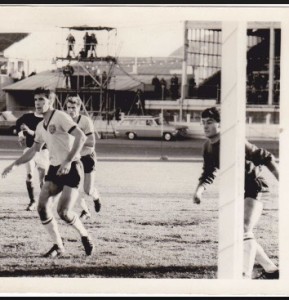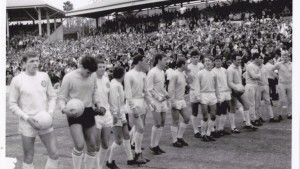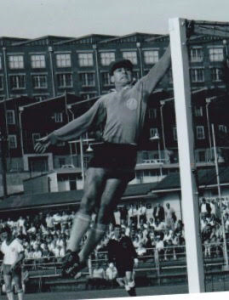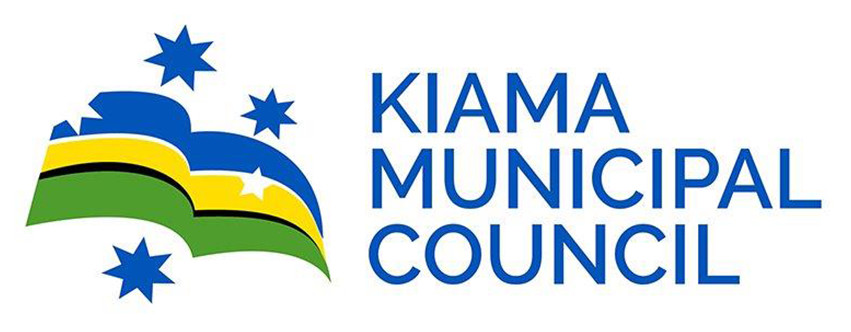Australian football has always witnessed a large production line of class goalkeepers.
From the late 1950’s through to the present day, Ron Lord, Jim Fraser, John Roberts, Ron Corry, Alan Maher, Yakka Banovic, Terry Greedy, Todd Clarke, Jeff Olver, Mark Bosnich, Mark Schwarzer and Matt Ryan are among the many custodians who have served the game with distinction.
However, perhaps the most gifted was Peter Fuzes, the former Hakoah, Apia, Canterbury and St George keeper who was denied a long career for the national team due to bureaucratic decision making.
Fuzes was like a cat in the penalty area as he would retrieve balls played behind his defence that no other keeper would dare to claim.
His agility in the air to collect or push balls around the post was a reflection of his wonderful technique in denying strikers goals which seemed impossible to stop.
He knew exactly when to collect crosses or hold his ground which was such a critical asset for his defensive unit.
Who knows where his career would’ve led if he’d been born thirty years later?
In this interview with Roger Sleeman, Peter Fuzes talks about the golden years of Australian football in the 1960’s, the great Hakoah teams, his short term international career, the current state of goalkeepers and Australian football standards.
ROGER SLEEMAN
Where did it all begin?
PETER FUZES
I came at the age of ten in 1957 to Australia as a Hungarian refugee and joined Hakoah juniors the following year.
I was extremely fortunate to be coached by Kurt Spiegel who was the first grade keeper at the time and he was able to lay the foundations for my future career.
Football was part of my upbringing in Hungary as we worshipped our great national teams of the 1950’s with my idols, the legendary Puskas and Bozsik, leading the country to World Cup success in 1954.
R.S.
When you first played senior football at Hakoah in the mid 60’s, there was a dominance of imported players so young local products found it hard to play regular games in first grade.
Was it a similar scenario to today’s A- League?
P.F.
Apart from myself, Robbie Fekete, Clive Thomson, Alex Coutts and Robbie Mcknight who did feature a lot, other players were competing for spots against more experienced players of a similar age who already had strong professional experience in the UK.
For example, former Soccceroos Alan Marnoch and Danny Walsh, were in that category and came to Australia in their early twenties.
Also, there were seasoned players like Trevor Edwards, the former Welsh international who played in the 1958 World Cup and Doug Holden who came to Australia at the age of 35 after playing for England five times after a distinguished career in the English Ist Division with Bolton Wanderers and Preston North End where he played over 500 first team games.
Holden was part of the famous Bolton team that lost to a Stanley Matthews inspired team 4-3 in the 1954 Cup Final, was part of the Bolton team which beat Manchester United in the 1958 Cup Final and scored in Preston’s loss to West Ham in the 1964 Cup Final.
Clearly, the quality of players who came here despite their advanced careers was vital in imparting knowledge and assisting the development of young players.
If we bring marquee players to the A-League they should be better than the local product and be able to leave a legacy which will guarantee a better local player.
R.S.
As a young boy growing up on a menu of class imports, I clearly recall the former Blackburn Rovers defender, Matt Woods joining Hakoah as captain coach from 1963-1965.
I’d never seen a central defender who was so tough and yet looked to have so much time on the ball.
There was also the Austrian maestro, Karl Jaros, who came to Hakoah from Prague in 1961.
Can you relate your thoughts on both of these wonderful performers?
P.F.
I remember my maiden game in first grade was against South Coast United in 1964 and Matt Woods opened my eyes to professionalism
He had come to Australia at the age of thirty two after more than 260 first team games with Blackburn Rovers but he never played for England because the famous Wolves defender, Billy Wright, had a mortgage on the centre half role.
When Wright retired from international duty, the national selectors chose younger players than Woods but he did have the distinction of playing for the Football League against the Scottish League.
In the 1960 FA Cup, Woods was the man of the match in Blackburn’s defeat by Wolves.
Jaros was the true professional who understood the game perfectly, played it in the right spirit and was a real winner.
His movement off the ball and the way he assisted his team-mates to go forward while maintaining possession would be a real eye opener to current Australian players who labour on the ball too long and maintain possession by playing back or wide which makes it so easy for opposing teams.
From the great Austrian players including Leo Baumgartner and Herbert Ninaus, Jaros was the only full Austrian international who came to the Prague club in 1959.
However, Erwin Ninaus from Prague and Adolph Blutsch from Hakoah did represent Austria later on at full level.
R.S.
Who were the greatest players you played with and your fiercest opponents?
P.F.
They would have to be the former Hakoah players Baartz, Watkiss, Marnoch, Yaager and Hillsdon.
In 1965 we won the Australia Cup, lost the final in 1966 and in 1968 won every competition in the season, including the Australia Cup.
Few people would be aware that before Brisbane Roar created their unbeaten streak of 38 games that the Hakoah team I played for were unbeaten in 28 games during the 1967 and 1968 seasons.
My fiercest opponents were John Giacometti and Max Tolson.
R.S.
Who were the best goalkeepers playing in your time in Australia and overseas?
P.F.
In Australia, Ron Lord who I rank as the best ever, Heinz Wentzel from Hakoah and Adauto Iglesias from Apia who played with Real Madrid before he came to Australia.
Overseas, there was Grosics, the Hungarian custodian who played like a sweeper in the 1950’s when he accelerated and sprinted over twenty metres which I tried to bring into my game.
Also Gordon Banks and Peter Shilton were in a class of their own.
However, I believe Pat Jennings was the best British keeper I’d ever seen as he played his first game for Spurs at the age of nineteen and his last game for Northern Ireland in the 1986 World Cup at the age of forty one.
R.S.
Can your relate your representative experiences?
P.F.
I was first selected for NSW in 1966 to play the touring AS Roma after Billy Rorke, the first choice keeper was injured.
In the following year, I was selected by national team coach, Joe Venglos, for the first and third matches against Scotland with ironically Billy Rorke playing the second game.
The Scottish team was captained by none other than Alex Ferguson who played on the right flank and also included future stars, Willie Morgan (Manchester United), and Jim McCalliog (Chelsea).
In October of that year, I was asked if I was available to be one of the goalkeepers to tour Vietnam for the National Day Football Tournament.
However, I was sitting for final university exams in early November and the Sydney University administration would not postpone all my exams till I arrived back so I had to decline selection in the squad.
Tragically, I was never selected to play for the national team again.

Playing against Scotland at the Sydney Showground. John Watkiss and Alan Marnoch in front of Peter Fuzes on his near post
R.S.
How do you rate the goalkeepers currently playing in the A- League and who are the pick of overseas custodians?
P.F.
Lawrence Thomas from Melbourne Victory is the pick of the crop, Liam Reddy with all that experience does a great job every week and he could have been anything in the game, Dean Bouzanis did a great job at Melbourne City last season, Jamie Young is solid for Brisbane Roar but lacks athleticism and Andrew Redmayne from Sydney F.C. needs to eliminate those lapses this season to become more consistent.
During the World Cup, Courtois was fantastic for Belgium, Pickford was a revelation for England and played a big part in their success and Lloris was great for France apart from his fatal dribble in the Final.
R.S.
What is your opinion of Australian football at the moment, particularly the A-League?
P.F.
I firmly believe the A-League was more exciting in the early years but we continue to lose players overseas without producing enough to replace them.
Hence, the standard has dropped with the exception of Sydney FC who have been extremely impressive.
I would like to see more technical and attacking football, even if more goals are conceded.
This may be strange comment from a former goalkeeper but football is in the entertainment business and more goal mouth action is critical to maintain public interest in the game.






